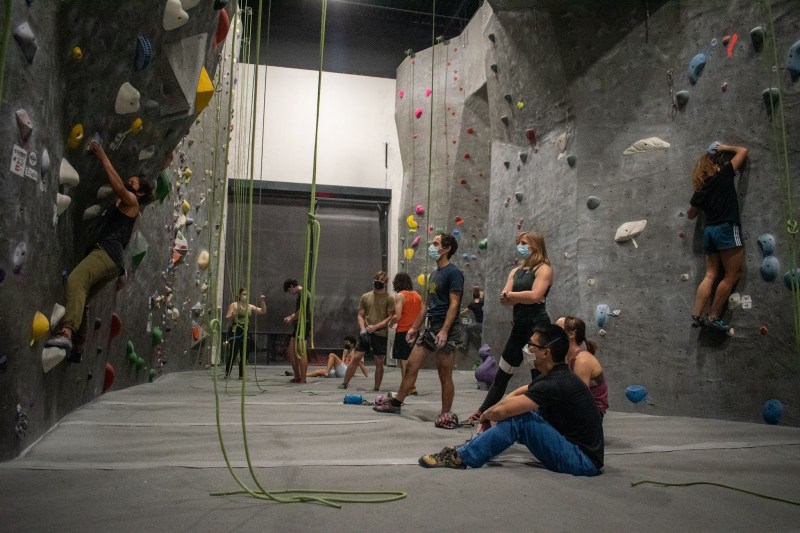Cheers and short yells erupt from members of Stanford’s Climbing Team as they maneuver around centimeter-wide holds at the Arrillaga Outdoor Education and Recreation Center (AOERC) climbing wall. Plumes of white permeate the air as climbers rub sweat-absorbing chalk powder on their hands.
Bouldering, sport climbing and trad (traditional) climbing are the forms most frequently practiced by the Stanford club sport team, which boasts about 50 members. Expertise levels range from newcomers to contestants on cult-favorite reality TV show American Ninja Warrior, such as seventh-year Ph.D. student Hunter Swan.
Founded about a decade ago, Stanford’s club team is relatively new. The team has been successful in collegiate competition, winning the national championship during the two years before the pandemic.
For some team members, the climbing community has been a home since their childhood.
Leila DeSchepper ’24 said she “started climbing at a friend’s birthday party when [she] was eight years old, loved it, and stuck with it.” Iso Nairn ’23 started at nine, after her uncle took her to a climbing gym where she was scouted by a staff member.
Each practice is “pretty open-form,” DeSchepper said, with team members crafting individualized training plans to follow during biweekly training sessions.
To vary the routes of ascension, the plastic holds are shifted around the formidable towers, generating new routes and complexities for team members to overcome. On weekends, climbers like Nairn enjoy venturing to outdoor locations like Yosemite and Mickey’s Beach.
Other Stanford climbers, such as Wren Cooperrider ’23 M.S. ’24 and Emmett Hough ’22, started pursuing climbing more intensively during the pandemic. “It’s a good way for me to spend time outside. It’s also a physical challenge, which I enjoy,” Cooperrider said.
Similarly, Hough started the sport because it satisfied his “athletic and adrenaline” needs. When gyms closed at the height of the pandemic, making it impossible for Hough to practice his main sport of gymnastics, Hough pivoted to outdoor climbing, where he could “translate skills such as flexibility, strength and body control.”
But for some team members, climbing is about more than just breaking a sweat — it is also a source of inspiration and purpose.
Take crimping and dyno enthusiast Krystal Gomez ’24, who started climbing in high school and went on to “co-found the first-ever high school rock climbing club in New York.” Discerning a barrier of entry for marginalized groups to enter the “empowering” sport, she made it her “duty to bring other female climbers into the community.”
“Stanford, in particular, is a very welcoming environment, but outdoor climbing has a bro-y culture,” Nairn said, adding that although men and women might appear to have equal eminence at higher levels of climbing, “there are still inequities.”
The sport has maintained a strong grip on Stanford culture since the 1940s and 1950s. During that time, climbing enthusiasts would scale the coarsely textured sandstone walls of Main Quad in what was dubbed “buildering” — an activity now prohibited on campus.
Following Stanford’s 2019 decision to remove the Arrillaga Center for Sports and Recreation climbing wall, the team is now advocating for a new outside wall at a location yet to be determined.
As the climbers wrap up their late-evening practice, they head to the grass outside for a core workout. Although the chalk powder smears may wash away, the memories forged from climbing together are indelible.
